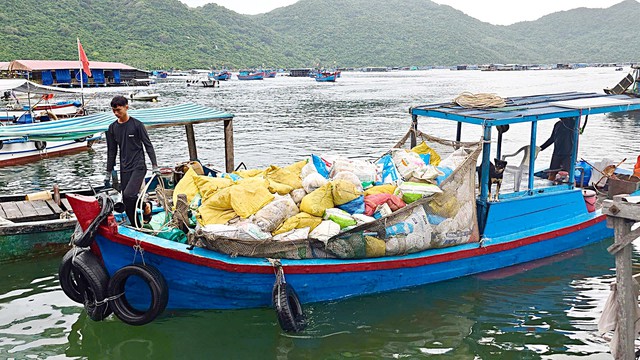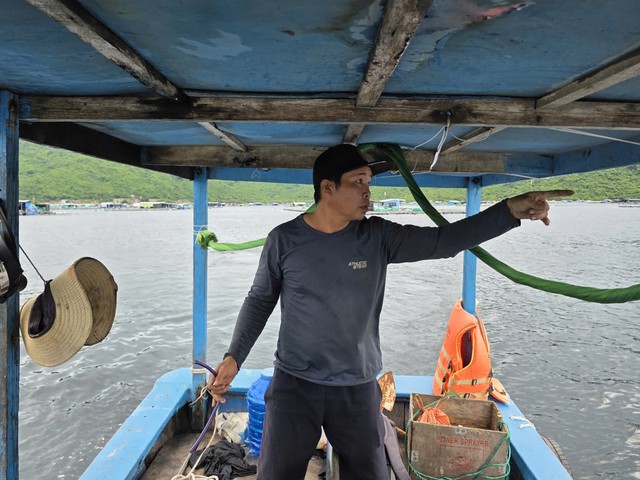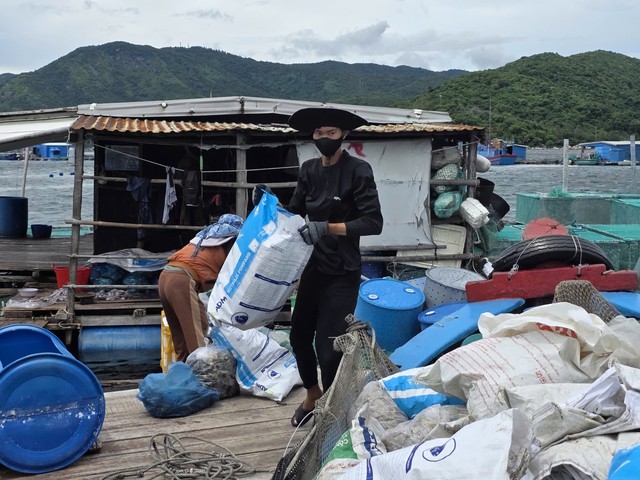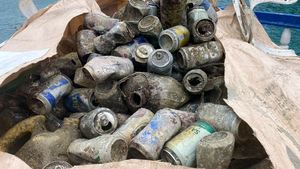
Community-backed marine waste collection model transforms Vietnam’s bay
For the past four months, a project backed by volunteers, local authorities, and the community to collect marine waste in Vung Ro Bay, Hoa Xuan Commune, Dak Lak Province, Vietnam has not only reduced pollution from thousands of aquaculture cages but also raised local awareness of environmental protection.

A boat used for collecting trash in Vung Ro Bay, Hoa Xuan Commune, Dak Lak Province, Vietnam. Photo: Minh Chien / Tuoi Tre
Amid thousands of floating cages on the bay, a small boat steered by 38-year-old Tran Thien Toan from neighboring Khanh Hoa Province patiently glides across the water to collect floating waste.
Driven by a desire to clean the sea and change local habits, Toan initially funded the project himself.
“At first, people didn’t believe in it,” Toan recalled.
“When I went to the cages to collect trash, some even laughed, thinking it was impossible.
“They were used to dumping waste directly into the water, but over time, as they saw our dedication, they started to understand and cooperate."
The model has been in operation since mid-May, making the water surface of the bay now noticeably cleaner without waste or discarded fishing nets.
In the past, residents often dumped waste indiscriminately, leaving the islands and shorelines covered in trash washed up by the waves.
The dense accumulation of garbage also worsened water quality in the area, directly affecting aquaculture farmers more than anyone else.
“Before, people threw trash into the sea without thinking, and I was always worried that the waste would cause disease outbreaks among my fish and shrimp,” said Tran Ngoc Huong, a 49-year-old aquaculture cage owner.
“Since the waste collection boat started operating, we’ve felt much more at ease knowing the garbage is taken ashore for proper treatment.
“We even wanted to contribute money because the job is so hard, but they said the service would be free for the first six months.
"We truly appreciate that.”
According to Tran Kim Trong, deputy chairman of Hoa Xuan Commune, this is Dak Lak’s first marine waste collection model.
The initiative has shown clear results, with over 90 percent of the cage owners now cooperating and becoming more environmentally conscious.
It has helped clean the sea, improve aquaculture conditions, and reduce disease risks.
After the initial six-month free period, local authorities plan to maintain the model sustainably by surveying residents and introducing a suitable fee system.
Vung Ro Bay currently has about 604 aquaculture cages.
A job of hardship
One day, Tuoi Tre (Youth) newspaper reporters followed a small boat crewed by 44-year-old Tran Quang Loc and 19-year-old Vo Kim Nien, as it made its way toward the aquaculture cages.

Tran Quang Loc said their workday starts at 6:00 am.
Loc said their workday starts at 6:00 am and ends only when the job is done, depending on the amount of waste and the weather, but rarely before 5:00 pm.
After a short ride, the boat pulled up to a fish farming raft where the owner had already packed all the trash into sacks.
Standing at the bow, Nien then jumped onto the raft, loaded five bags of garbage onto the boat, and quickly moved on.
The same routine repeated hundreds of times across Vung Ro Bay.
The boat grew heavier with each stop, while the crew’s clothes, hats, and masks were soaked with sweat.
According to Loc, collecting trash at sea is hard work, especially on stormy or windy days.
Steering a small, garbage-laden boat from the bay to shore in rough waters is not only exhausting but also dangerous.
“In the early days, when a lot of waste, especially plastic bags and sacks, was floating around, we had to dive almost every day to untangle it from the propeller,” Loc said.
“It was very tough, especially on days with rough weather and large amounts of waste.”

Vo Kim Nien is in charge of collecting trash from the fish farming rafts.
Normally, each trip collects more than two metric tons of waste, and nearly four metric tons during peak months.
The trash is brought back to a local dock, then loaded onto trucks and transported to Mon Lagoon in Khanh Hoa for disposal.
“The residents are very cooperative now,” Nien said.
“When they see our boat coming, some even bring their trash bags out to help.
“Collecting trash at sea is much harder than on land.
"Besides gathering garbage from the fish rafts, we also have to scoop up floating waste from the water surface, but seeing the sea clean makes us really happy."
Before working in Vung Ro Bay, Tran Thien Toan had spent more than six years operating a similar model in Van Phong Bay, Khanh Hoa Province.
“After Vung Ro, I’m planning to expand the sea waste collection model to Xuan Dai Bay, which is home to a high density of lobster farms of Dak Lak Province,” Toan shared.
Minh Chien - Dong Nguyen / Tuoi Tre News
Link nội dung: https://news.tuoitre.vn/community-backed-marine-waste-collection-model-transforms-vietnams-bay-103251015104941412.htm
